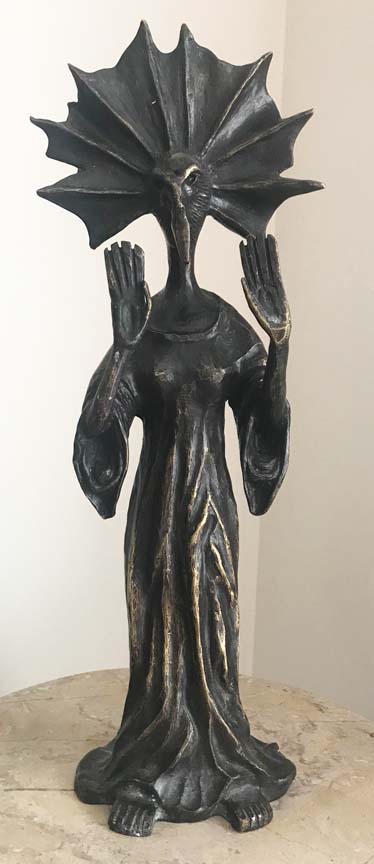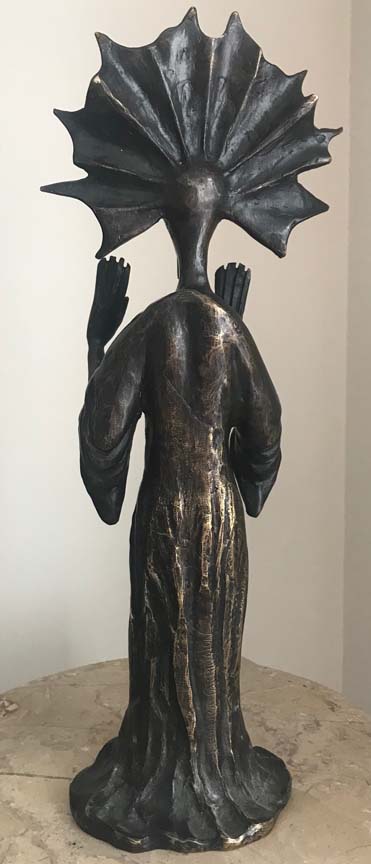



LEONORA CARRINGTON
(AFTER)
"THE PALMIST"
BRONZE, SIGNED
MEXICO, C.1960
17 INCHES
Leonora Carrington 1917-2011 Leonora Carrington's father was a wealthy industrialist; her mother was Irish. She also had an Irish nanny, Mary Cavanaugh, who told her Gaelic tales. Carrington had three brothers, and places she lived as a child included a house called Crooksey Hall. Educated by governesses, tutors and nuns, she was expelled from many schools for her rebellious behavior until her family sent her to Florence where she attended Mrs. Penrose's Academy of Art. Her father was opposed to an artist's career for her, but her mother encouraged her. She returned to England and was presented at Court, but according to her, instead of paying attention to those proceedings, she brought a book to read by Aldous Huxley, Eyeless in Gaza (1936). In London she attended the Chelsea School of Art and joined the Academy of Amédée Ozenfant. She saw her first Surrealist painting in a Left Bank gallery in 1927 when she was ten years old, and met many surrealists, including Paul Eluard. (She was already familiar with surrealism from Herbert Read's book.) Carrington saw Max Ernst's work in a 1936 international Surrealist exhibition in London and was immediately attracted to the Surrealist artist before actually meeting him. She met Max Ernst at a party in London in 1937. The artists bonded and returned to Paris together where Ernst promptly separated from his wife. In 1938, they left Paris and settled in Saint Martin d'Ardèche in the Provence region, of the south of France. The new couple collaborated and supported each other's artistic development. With the outbreak of World War II, Max Ernst was arrested by French authorities for being a "hostile alien". Thanks to the intercession of Paul Eluard, and other friends including the American journalist Varian Fry he was discharged a few weeks later. Soon after the French occupation by the Nazis, he was arrested again, this time by the Gestapo, but he managed to escape and flee to America with the help of Peggy Guggenheim, a sponsor of the arts. After the Germans invaded their French village and took Ernst in custody in 1940, a devastated Carrington fled to Spain. Paralyzing anxiety and growing delusions culminated in a final breakdown at the British Embassy in Madrid. Her parents intervened and had her institutionalized, and she was given cardiazol, a powerful shock-inducing drug. When released into the care of a nurse who took her to Lisbon, Carrington ran away and sought refuge in the Mexican Embassy. Ernst meanwhile had been extricated from Europe with Peggy Guggenheim, but he and Carrington had experienced so much misery that they were unable to reconnect. After having escaped in Lisbon, Carrington arranged passage out of Europe with a Mexican diplomat who was a friend of Picasso. In fact, she married the diplomat as part of the travel arrangements. Events from that period would inform her work perhaps forever. She lives and works in Mexico and New York. "I didn't have time to be anyone's muse...I was too busy rebelling against my family and learning to be an artist." --Leonora Carrington, 1983 In Mexico she would later marry Emericko Weisz and would have two children.The first son - Gabriel Weisz is an intellectual and a poet, and the second son Pablo Weisz is a surrealist artist and a doctor. The first important exhibition of her work appeared in 1947 at the Pierre Matisse Gallery in New York City. Leonora Carrington was invited to show her work in an international exhibition of Surrealism where she was the only female English professional painter. She became a celebrity almost overnight. In Mexico she authored and has had published several books. Source: "Leonora Carrington," Wikipedia, Web, March 2016
|